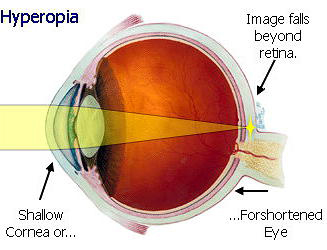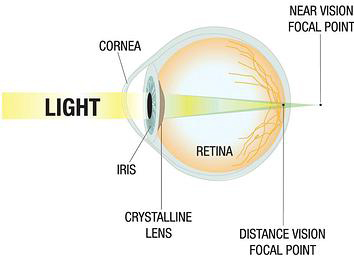Nearsightedness
 Nearsightedness (myopia) is caused by an eyeball that is too long, causing light rays to fall in front of the retina.
Nearsightedness (myopia) is caused by an eyeball that is too long, causing light rays to fall in front of the retina.
The symptoms of shortsightedness often start around puberty and get gradually worse until the eye is fully grown. Therefore it’s important to have regular eye examinations.
If you notice that distant objects seem to be fuzzy or your child is struggling to see things in the distance, such as the blackboard at school, you should arrange for a sight test with a professional optometrist.
If you notice that distant objects seem to be fuzzy or your child is struggling to see things in the distance, such as the blackboard at school, you should arrange for a sight test with a professional optometrist.
Treatments & Suggestions
There are three main treatment options for short-sightedness.
There are three main treatment options for short-sightedness.
- Corrective lenses, such as glasses or contact lenses
- Laser surgery such as LASIK or SMILE after 18 years old
- implanting an artificial lens into the eye
Farsightedness
 Farsightedness (hyperopia) is caused by the eyeball being too short, causing light rays to focus before the retina.
Farsightedness (hyperopia) is caused by the eyeball being too short, causing light rays to focus before the retina.
Children are sometimes born farsighted. The problem usually corrects itself as the child’s eyes develop. However, it is important for children to have regular eyes tests because farsightedness that does not correct itself can lead to other eye-related problems.
Adults can also develop long-sightedness, which often becomes more noticeable after the age of 40. Age-related long-sightedness is known as presbyopia.
Treatments & Suggestions
Treatments & Suggestions
Farsightedness can be corrected with convex corrective lenses such as in spectacles or contact lenses. Other ways to correct hyperopia are refractive surgery options.
Astigmatism
 Astigmatism is a condition where the cornea has an abnormal curvature, causing a distortion in vision. A normal cornea is shaped like a sphere but in astigmatism the cornea is oval-shaped, causing problems in focusing the light entering the eye.
Astigmatism is a condition where the cornea has an abnormal curvature, causing a distortion in vision. A normal cornea is shaped like a sphere but in astigmatism the cornea is oval-shaped, causing problems in focusing the light entering the eye.If left untreated, astigmatism can also cause headaches and eye strain.
Treatments & Suggestions
In many cases, the symptoms of astigmatism are so mild that no treatment is needed to correct your vision. In cases where your vision is significantly affected by astigmatism, corrective lenses such as glasses or contact lenses can be used to correct it. And laser treatment can be used to permanently correct astigmatism in adults.
Presbyopia
 Presbyopia occurs when the natural lens in the eye loses its elasticity and ability to change shape as a person gets older. The loss of elasticity in the lens makes it less able to focus light accurately to when looking at near objects.
Presbyopia occurs when the natural lens in the eye loses its elasticity and ability to change shape as a person gets older. The loss of elasticity in the lens makes it less able to focus light accurately to when looking at near objects.Presbyopia is a condition that affects most people over the age of 40.
Treatments & Suggestions
Presbyopia can be corrected with special spectacle lenses called bifocals to help correct the condition.



